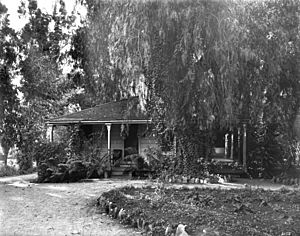Hugo Reid Adobe facts for kids
The Hugo Reid Adobe, also known as the Reid-Baldwin Adobe, is a historic home built in 1839. It's made from adobe, which are sun-dried mud bricks. You can find this old house today at the Los Angeles County Arboretum and Botanic Garden in Arcadia, California.
This special building was named a California Historical Landmark (number 368) on April 3, 1940. A man named Hugo Reid, who was from Scotland but also Mexican, built the adobe. He got help from local native people. It sits near what is now called Baldwin Lake.
Hugo Reid received a large Mexican land grant for Rancho Santa Anita in 1845. This grant gave him ownership of 13,319 acres of land. Reid used some of this land for farming and planted grape vines.
Contents
Who Was Hugo Reid?
Hugo Reid (born April 18, 1811) was originally from Scotland. He became an early resident of Los Angeles County. At that time, California was part of Mexico. Reid became a citizen of Mexico.
He married a local Native American woman named Victoria. She was from the Gabrieleño people. Victoria grew up at the San Gabriel Mission.
Lucky Baldwin's Time
Elias Jackson “Lucky” Baldwin bought Rancho Santa Anita in 1875. In 1879, Baldwin added a wooden section to the old adobe home.
Elias Jackson "Lucky" Baldwin (born April 3, 1828) was a very successful businessman. He was an investor and bought a lot of land in California during the 1800s. He earned the nickname "Lucky" because he had amazing good fortune in many of his business deals.
Baldwin built a fancy hotel and theater in San Francisco. He also bought huge amounts of land in Southern California. Many places and neighborhoods in the area are still named after him today.
Saving the Adobe
In 1947, the state and county bought the land where the adobe stands. They wanted to create an arboretum around the lake. An arboretum is like a botanical garden, but it focuses on trees and shrubs. This helped protect the historic Reid-Baldwin buildings.
Rebuilding the Adobe
Adobe buildings need a lot of care, especially their roofs. If a roof is not good, adobe structures can get damaged very quickly. Even with a good roof, they need constant maintenance. The Hugo Reid Adobe has been repaired and rebuilt over time.
The original house was made from sun-dried adobe bricks. These bricks are made by mixing clay soil, water, and straw for strength. The first roof of the adobe home was made of rawhide animal skin. This was used to tie giant cane reeds together. Then, the roof was covered with tar. When the Hugo Reid Adobe was rebuilt, people tried to use many of the original building methods and materials.
Historical Marker
A special marker at the site tells part of the adobe's history:
- NO. 368 HUGO REID ADOBE - Hugo Reid, a Scotsman, asked the Mexican government for the Rancho Santa Anita land. His claim was made stronger by his marriage to Victoria, a Native American woman from the San Gabriel Mission. He received the land on April 16, 1841. As soon as he asked for the land, Reid took control of it. He started farming and planting vineyards. He built the first house, the Hugo Reid Adobe, in 1839. In 1875, E. J. Baldwin bought the rancho. In 1879, he added a wooden part to the old adobe.


